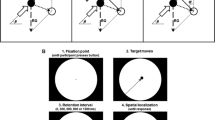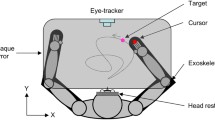Abstract
Smooth pursuit eye movements change the retinal image velocity of objects in the visual field. In order to change from a retinocentric frame of reference into a head-centric one, the visual system has to take the eye movements into account. Studies on motion perception during smooth pursuit eye movements have measured either perceived speed or perceived direction during smooth pursuit to investigate this frame of reference transformation, but never both at the same time. We devised a new velocity matching task, in which participants matched both perceived speed and direction during fixation to that during pursuit. In Experiment 1, the velocity matches were determined for a range of stimulus directions, with the head-centric stimulus speed kept constant. In Experiment 2, the retinal stimulus speed was kept approximately constant, with the same range of stimulus directions. In both experiments, the velocity matches for all directions were shifted against the pursuit direction, suggesting an incomplete transformation of the frame of reference. The degree of compensation was approximately constant across stimulus direction. We fitted the classical linear model, the model of Turano and Massof (2001) and that of Freeman (2001) to the velocity matches. The model of Turano and Massof fitted the velocity matches best, but the differences between de model fits were quite small. Evaluation of the models and comparison to a few alternatives suggests that further specification of the potential effect of retinal image characteristics on the eye movement signal is needed.
Similar content being viewed by others
References
Aubert H (1886) Die Bewegungsemp findung. Pflügers Archiv 39: 347–370.
Aubert H (1887) Die Bewegungsemp findung, zweite Mitteilung. Pflügers Archiv 40: 459–480.
Barton JJS, Simpson T, Kiriakopoulos E, Stewart C, Crawly A, Guthrie B, et al. (1996). Functional MRI of lateral occipitotemporal cortex during pursuit and motion perception. Annals of Neurology 40: 387–398.
Becklen R, Wallach H, Nitzberg D (1984) A limitation of position constancy. Journal of Experimental Psychology: Human Perception and Performance 10: 713–723.
Bradley DC, Maxwell M, Andersen RA, Banks MS,Shenoy KV (1996) Mechanisms of heading perception in primate visual cortex. Science 273: 1544–1547.
De Bruyn B, Orban GA (1988) Human velocity and direction discrimination measured with random dot patterns. Vision Research 28: 1323–1335.
De Graaf B, Wertheim AH (1988) The perception of object-motion during smooth-pursuit eye movements: Adjacency is not a factor contributing to the Filehne illusion. Vision Research 28: 497–502.
Festinger L, Easton AM (1974) Inferences about the efferent system based on a perceptual illusion produced by eye movements. Psychological Review 81(1): 44–58.
Festinger L, Sedgwick HA, Holtzman JD (1976) Visual perception during smooth pursuit eye movements. Vision Research 16: 1377–1386.
Filehne W (1922) Über das optische Wahrnehmen von Bewegungen. Zeitschrift für Sinnesphysiologie 53: 134–144.
Freeman TCA (2001) Transducer models of head-centred motion perception. Vision Research 41: 2741–2755.
Freeman TCA, Banks MS (1998) Perceived head-centric speed is affected by both extra-retinal and retinal errors. Vision Research 38: 941–945.
Goltz HC, DeSouza JFX, Menon RS, Tweed DB, Vilis T (2003) Interaction of retinal image and eye velocity in motion perception. Neuron 39: 569–576.
Hansen RM (1979) Spatial localization during pursuit eye movements. Vision Research 19: 1213–1221.
Holtzman JD, Sedgwick H A, Festinger L (1978) Interaction of perceptually monitored and unmonitored efferent commands for smooth pursuit eye movements. Vision Research 18: 1545–1555.
Ilg U J, Thier P (2003) Visual tracking neurons in primate area MST are activated by smooth-pursuit eye movements of an “imaginary target”. Journal of Neurophysiology 90: 1489–1502.
Mack A, Herman E (1973) Position constancy during pursuit eye movement: An investigation of the Filehne illusion. Quarterly Journal of Experimental Psychology 25: 71–84.
Mack A, Herman E (1978) The loss of position constancy during pursuit eye movements. Vision Research 18: 55–62.
Mateeff S (1978) Saccadic eye movements and localization of visual stimuli. Perception and Psychophysics 24: 215–224.
Mateeff S, Yakimoff N, Hohnsbein J, Ehrenstein WH (1991) Perceptual constancy during ocular pursuit: A quantitative estimation procedure. Perception and Psychophysics 49: 390–392.
Matin L, Matin E, Pearce DG (1969) Visual perception of direction when voluntary saccades occur. I. Relation of visual direction of a fixation target extinguished before a saccade to a flash presented during the saccade. Perception and Psychophysics 5: 65–80.
Matin L, Matin E, Pola J (1970) Visual perception of direction when voluntary saccades occur: II. Relation of visual direction of a fixation target extinguished before a saccade to a subsequent test flash presented before the saccade. Perception and Psychophysics 8: 9–14.
McKee SP, Nakayama K (1984) The detection of motion in the peripheral visual field. Vision Research 24: 25–32.
Mergner T, Becker W (1990) Perception of horizontal self-rotation: Multisensory and cognitive aspects. In: R Warren and AH Wertheim (eds.), Perception and control of self-motion. Erlbaum, Hillsdale, NJ, pp. 219–263.
Mergner T, Wertheim AH, Rumberger A (2000) Which retinal and extra-retinal information is crucial for circular vection? Archives Italiennes de Biologie 138: 123–138.
Newsome WT, Wurtz RH, Komatsu H (1988) Relation of cortical areas MT and MST to pursuit eye movements. II. Differentiation of retinal from extraretinal inputs. Journal of Neurophysiology 60: 604–620.
Pack C, Grossberg S, Mingolla E (2001) A neural model of smooth pursuit control and motion perception by cortical area MST. Journal of Cognitive Neuroscience 13: 102–120.
Park J. Lee J, Lee C (2001) Non-veridical visual motion perception immediately after saccades. Vision Research 41: 3751–3761.
Pitt MA, Myung IJ (2002) When a good fit can be bad. Trends in Cognitive Sciences 6: 421–425.
Post RB, Leibowitz HW (1985) A revised analysis of the role of efference in motion perception. Perception 14: 631–643.
Shenoy KV, Bradley DC, Andersen RA (1999) Influence of gaze rotation on the visual response of primate MSTd neurons. Journal of Neurophysiology 81: 2764–2786.
Souman JL, Hooge ITC, Wertheim AH (2004) How smooth pursuit eye movements affect the perceived direction and speed of moving objects. Perception, 33(Supplement): 3a.
Souman JL, Hooge ITC, Wertheim AH (2005a) Vertical object motion during horizontal ocular pursuit: Compensation for eye movements increases with presentation duration. Vision Research 45: 845–853.
Souman JL, Hooge ITC, Wertheim AH (2005b) Perceived motion direction during smooth pursuit eye movements. Experimental Brain Research 164: 376–386.
Sumnall JH, Freeman TCA, Snowden RJ (2003) Optokinetic potential and the perception of head-centred speed. Vision Research 43: 1709–1718.
Swanston MT, Wade NJ (1988) The perception of visual motion during movements of the eyes and of the head. Perception and Psychophysics 43: 559–566.
Swanston MT, Wade NJ, Day RH (1987) The representation of uniform motion in vision. Perception 16: 143–159.
Swanston MT, Wade NJ, Ono H, Shibuta K (1992) The interaction of perceived distance with the perceived direction of visual motion during movements of the eyes and the head. Perception and Psychophysics 52: 705–713.
Turano KA, Heidenreich SM (1999) Eye movements affect the perceived speed of visual motion. Vision Research 39: 1177–1187.
Turano KA, Massof RW (2001) Nonlinear contribution of eye velocity to motion perception. Vision Research 41: 385–395.
Von Fleischl E (1882) Physiologisch-optische Notizen. Sitzungsberichte der Akademie der Wissenschaften in Wien 3(86): 7–25.
Von Holst E (1954) Relations between the central nervous system and the peripheral organs. British Journal of Animal Behavior 2: 89–94.
Von Holst E, Mittelstaedt H (1950) Das Reafferenzprinzip (Wechselwirkungen zwischen Zentralnervensystem und Peripherie). Die Naturwissenschaften 37: 464–476.
Wade NJ, Swanston MT (1987) The representation of nonuniform motion: Induced movement. Perception 16: 555–571.
Wade NJ, Swanston MT (1996) A general model for the perception of space and motion. Perception 25: 187–194.
Wallach H, Becklen R, Nitzberg D (1985) The perception of motion during colinear eye movements. Perception and Psychophysics 38: 18–22.
Wertheim AH (1987) Retinal and extraretinal information in movement perception: How to invert the Filehne illusion. Perception 16: 299–308.
Wertheim AH (1990) Visual, vestibular, and oculomotor interactions in the perception of object motion during egomotion. In: R Warren and AH Wertheim (eds.), Perception and control of self-motion. Erlbaum, Hillsdale, NJ, pp. 171–217.
Wertheim AH (1994) Motion perception during self-motion: The direct versus inferential controversy revisited. Behavioral and Brain Sciences 17: 293–355.
Author information
Authors and Affiliations
Corresponding author
Rights and permissions
About this article
Cite this article
Souman, J.L., Hooge, I.T.C. & Wertheim, A.H. Frame of reference transformations in motion perception during smooth pursuit eye movements. J Comput Neurosci 20, 61–76 (2006). https://doi.org/10.1007/s10827-006-5216-4
Received:
Revised:
Accepted:
Published:
Issue Date:
DOI: https://doi.org/10.1007/s10827-006-5216-4




